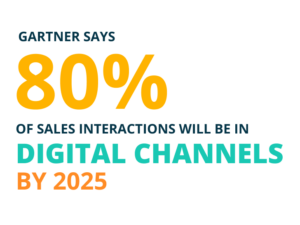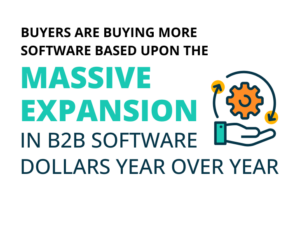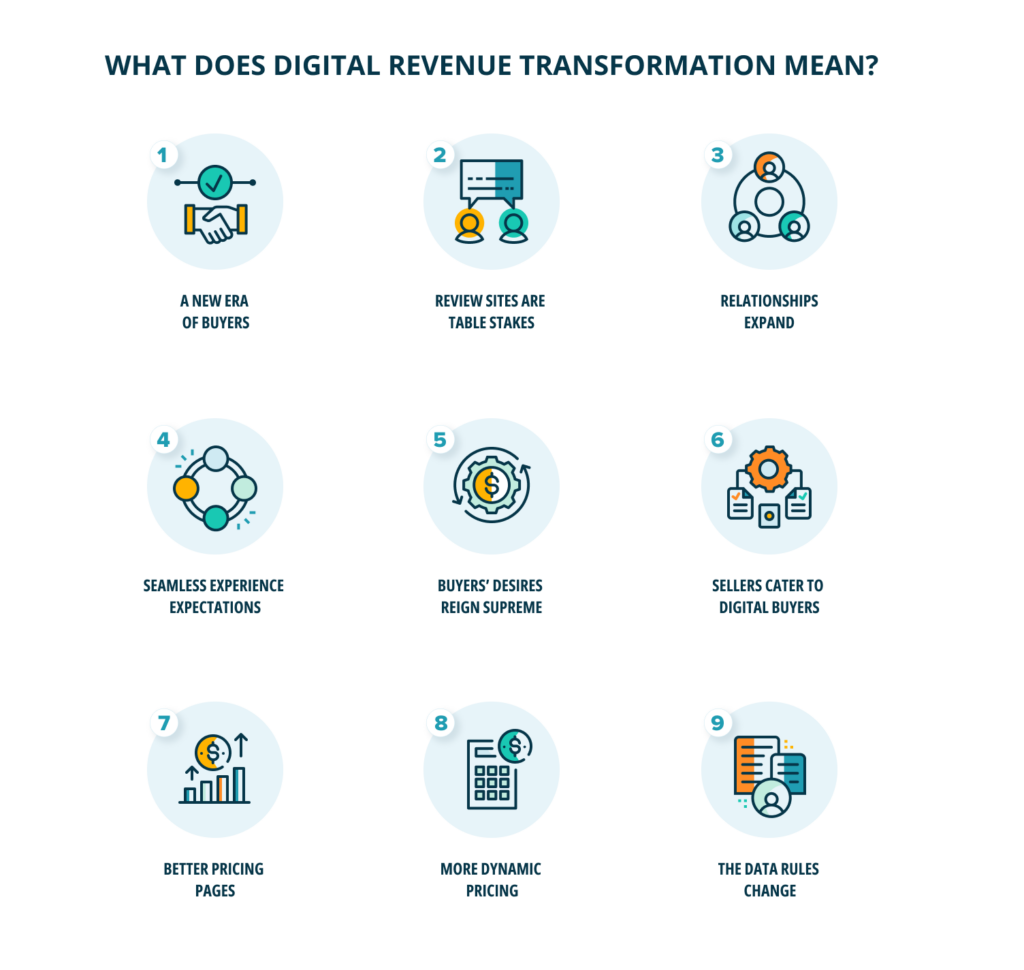Tackle CEO John Jahnke shares his vision for the future of software sales, and what has to change to get there.
B2B selling and buying is broken. There is friction at every turn and go-to-market systems are growing more complex by the day. Why is it that, in a software-driven business world, it’s still so hard to buy and sell software?
Buyer behavior is changing. Gartner says 80% of sales interactions will be in digital channels by 2025. But most go-to-market systems are not built for this future. 
No matter how much chatter you hear about product-led growth, usage-based pricing, and Cloud Marketplaces, the reality is we are currently operating in a human-based era of go-to-market. Leaders build business plans around the people that bring their go-to-market to life. The real question is — given all these new ways of selling — what is standing in the way of these new motions truly becoming the primary way that software companies sell?
I talk a lot about this in a keynote I hosted over the summer, and I wanted to expand a bit further on the idea of human-based go-to-market.
How companies GTM today
It all starts at the top, with the plan. For software companies, building your annual plan is a mix of art and science, and the younger your company, the more difficult and art-based your planning process is.
If you’re a CEO, CRO, or CFO you’ll start planning with the current number of sales reps, then an estimated quota number, and expected production. Next, you do some math against where you want to be next year to figure out how many people are required to hit that goal.
There are many factors, but it ultimately all starts with people.
Building an integrated go-to-market system is hard. Really hard.
Next, you’ll move to the people in the supporting layers of the system — marketing, renewals and expansion, customer success, partners — and see what each of these organizations can contribute.
If the company has a strong product and solid net dollar retention, renewals should contribute new ARR to the plan via expansion, but all other functions tend to focus on lead input into the system. Everyone is doing math around leads and conversion rates and trying to be as accurate as possible, but there are a lot of variables in these layers.
At this point, you have a multi-faceted group of people who all need to work together to deliver on the original plan, but all of these teams work in different ways. Further, these teams often work in different tools, and many of these tools operate in silos where integration can be complex and time-consuming.
CRMs, like Salesforce, are considered a “source of truth” for most organizations, but require manual data entry and upkeep, are built on top of lagging indicators, and lack real-time visibility.
This leads to people-based systems that operate in offline ways and are not truly connected to each other. While more tools are emerging – almost daily – to help improve many segments of this GTM ecosystem, most of these new tools only address a narrow slice of the problem.
Building an integrated go-to-market system is hard. Really hard.
The reality is a true GTM system-level observability is not possible today.
As you scale, you start to add more business models, more ways of selling, and communities and ecosystem to support your product and users. This includes multiple packages, free trials, bottoms-up motions, top-down enterprise sales motions, and new digital selling motions like the Marketplaces and product-led growth.
At this point if you tried mapping out your end-to-end integrated GTM system it would probably look more like a maze than a map.
Today’s GTM isn’t sustainable
Ultimately, something must be working. More software companies than ever are being started and more venture dollars than ever are flowing into these companies. Buyers are buying more software based upon the massive expansion in B2B software dollars year over year. 
But when you add it all up, working in this human-based, offline way is expensive, wasteful, and unpredictable. The cost of GTM systems is growing significantly and paying $1-2 dollars for every $1 dollar of ARR is not sustainable.
All companies, leaders, and investors want to drive revenue in a predictable way. To paraphrase ex-Google Executive Chairman Eric Schmidt, revenue solves all problems and lack of predictability makes people nervous.
While human-based systems are predictable from a planning standpoint—in the words of Mike Tyson—“everyone has a plan until they get punched in the mouth.”
It is easy for CEOs, CROs, and CFOs to build up and to the right models, but it all depends on people. According to Forrester, average sales attainment is roughly 45%, which means you have to pay for way more capacity than you actually need to make the plan you create. And it’s no longer just about sales. It is about all of those integrated layered organizations that make up your GTM system — marketing, partners, sales, and customer success all working together as one integrated system.
Short-term, we anticipate the problem will become even more complex as companies add more channels, business models, people, tools which all equals complexity and cost.
Something needs to change.
This is why I believe we are in the earliest days of a massive shift in the way that software companies generate revenue—a digital revenue transformation.

The future of software sales
Ten years from now, the nature of software sales will look very different than it does today. What does digital revenue transformation mean? A few things:
- A new era of buyers: Gartner says buyers spend 83% of their time on other activities before ever engaging with potential suppliers. When buyers do engage, they will look for and desire help, but this help will likely come late in their analysis process.
- Review sites are table stakes: Reviews and user feedback will become more important to B2B buying as more buyers spend less time with suppliers and look to leverage their peers as experts
- Relationships expand: Communities and ecosystems will play a bigger and bigger role in sharing the social proof of successful users.
- Seamless experience expectations: Buyers will look for and expect expert assistance and a seamless digital experience beyond emails, spreadsheets, PDF quotes, and Zoom calls. Think Carvana vs old school dealers with paper and fake managers negotiating prices.
- Buyers’ desires reign supreme: Buyers will want to buy in the way that makes most sense to them—bottoms-up, tops-down, free trial, usage-based, Marketplaces, or most likely combination of all.
- Sellers cater to digital buyers: Sellers will need to sell where buyers want to buy. This will be digital and could be many places. For simplicity’s sake, we will say the future of software sales will include multi-channel ecommerce.
- Better pricing pages: Pricing pages will be intuitive, transparent, and actionable, unlike most pricing pages today. They will become an actual purchase point for buyers rather than a barrier to speak to a sales rep.
- More dynamic pricing: Pricing will evolve to be more dynamic than the traditional annual price change that happens in most B2B companies.
- The data rules change: Sellers will no longer tolerate having to enter data into multiple locations (or at all) and buyers will get more restrictive with the information they enter and share.
Leaders will become experts in digital selling and engaging with their buyers wherever they want to be met. The darlings of product-led growth are the best examples of this today. We can all learn from these companies, but their products tend to have simple value propositions to users which makes adoption more intuitive. Most B2B software ends up being more complex.
In the future, humans will complement a software-based GTM system and not the other way around.
The shift is similar in scale to the shift that took place in the pre-cloud to post-cloud era with infrastructure. Non-elastic; expensive; pay for peak, not for usage. How can we bring similar scale principles into go-to-market systems over the next 10 years?
Ultimately in the future, humans will complement a software-based GTM system and not the other way around. If you squint your eyes and turn your head, you can see the leading indicators of this future. Product-led growth, usage-based pricing, and Marketplaces are all strong signals of a software-based GTM system. Also, every software company is struggling with the need to build software to sell software. No one wants to do it—everyone wants to focus on core value propositions.
The future of software GTM will be online; it will be digital. There will be many different solutions making up these GTM systems, but they will all work together in seamless ways with the core premise that buyers will buy in an ever growing number of ways (multi-channel e-commerce), sellers will help buyers buy via digital experiences (online/collaborative), and GTM systems will require seamless integration with deep instrumentation, logging, and observability.
This is the future state we are excited to be part of and are working hard to bring to life.
Frequently asked questions (FAQs)
What is the best way to market a new software product?
In today’s software e-commerce environment, companies should adopt a Cloud Go-to-Market strategy. This strategy involves cooperative partnerships with the major cloud hyperscalers and puts your product front-and-center where buyers are and prefer to make purchases today. In addition, these partnerships with Cloud Providers can also pave the way for other benefits, such as co-selling.
Why are current go-to-market systems inadequate?
The main problems with today’s go-to-market systems is a lack of transparency and observability. Companies are siloed, and different business units that should be talking to each other in order to make the system work simply aren’t sharing the right data at the right time, or they have no insight into why decisions are being made. This lack of insight and shared data across the enterprise leads to confusion and poor decision making.
Why is today’s GTM considered unsustainable?
As companies add more channels, business models, and people, more tools will be required to connect all of these disparate processes and systems. That adds a significant layer of complexity that will only muddy the waters. Enterprise grade Cloud GTM systems like Tackle can help connect people, processes, and technology so that the right information and insights are shared and readily available.

